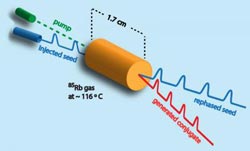First light: NIST researchers develop new way to generate superluminal pulses

In four-wave mixing, researchers send "seed" pulses of laser light into a heated cell containing atomic rubidium vapor along with a separate "pump" beam at a different frequency. The vapor amplifies the seed pulse and shifts its peak forward, making it superluminal. At the same time, photons from the inserted beams interact with the vapor to generate a second pulse called the "conjugate." Its peak, too, can travel faster or slower depending on how the laser is tuned and the conditions inside the gain medium. Credit: NIST<br>
The technique, called four-wave mixing, reshapes parts of light pulses and advances them ahead of where they would have been had they been left to travel unaltered through a vacuum. The new method could be used to improve the timing of communications signals and to investigate the propagation of quantum correlations.
According to Einstein's special theory of relativity, light traveling in a vacuum is the universal speed limit. No information can travel faster than light.
But there's kind of a loophole. A short burst of light arrives as a sort of (usually) symmetric curve like a bell curve in statistics. The leading edge of that curve can't exceed the speed of light, but the main hump, the peak of the pulse, can be skewed forward or backward, arriving sooner or later than it normally would.
Recent experiments have generated “uninformed” faster-than-light pulses by amplifying the leading edge of the pulse and attenuating, or cutting off, the back end. The method introduces a great deal of noise with no great increase in the apparent speed. Four-wave mixing produces cleaner, less noisy pulses with a greater increase in speed by “re-phasing” or rearranging the light waves that make up the pulse.
In four-wave mixing, researchers send 200-nanosecond-long “seed” pulses of laser light into a heated cell containing atomic rubidium vapor along with a separate “pump” beam at a different frequency from the seed pulses. The vapor amplifies the seed pulse and shifts its peak forward so that it becomes superluminal. At the same time, photons from the inserted beams interact with the vapor to generate a second pulse, called the “conjugate” because of its mathematical relationship to the seed. Its peak, too, can travel faster or slower depending on how the laser is tuned and the conditions inside the laser.
In the experiment, the pulses' peaks arrived 50 nanoseconds faster than light traveling through a vacuum.
One immediate application that the group would like to explore for this system is quantum discord. Quantum discord mathematically defines the quantum information shared between two correlated systems—in this case, the seed and conjugate pulses. By performing measurements of quantum discord between fast beams and reference beams, the group hopes to determine how useful this fast light could be for the transmission and processing of quantum information.
* R. Glasser, U. Vogl and P. Lett. Stimulated generation of superluminal light pulses via four-wave mixing. Physical Review Letters, published online April 26, 2012.
Media Contact
More Information:
http://www.nist.govAll latest news from the category: Physics and Astronomy
This area deals with the fundamental laws and building blocks of nature and how they interact, the properties and the behavior of matter, and research into space and time and their structures.
innovations-report provides in-depth reports and articles on subjects such as astrophysics, laser technologies, nuclear, quantum, particle and solid-state physics, nanotechnologies, planetary research and findings (Mars, Venus) and developments related to the Hubble Telescope.
Newest articles

Bringing bio-inspired robots to life
Nebraska researcher Eric Markvicka gets NSF CAREER Award to pursue manufacture of novel materials for soft robotics and stretchable electronics. Engineers are increasingly eager to develop robots that mimic the…

Bella moths use poison to attract mates
Scientists are closer to finding out how. Pyrrolizidine alkaloids are as bitter and toxic as they are hard to pronounce. They’re produced by several different types of plants and are…

AI tool creates ‘synthetic’ images of cells
…for enhanced microscopy analysis. Observing individual cells through microscopes can reveal a range of important cell biological phenomena that frequently play a role in human diseases, but the process of…





















